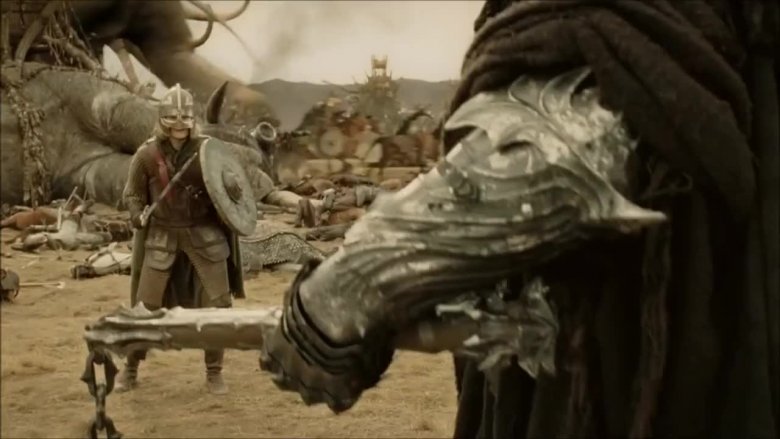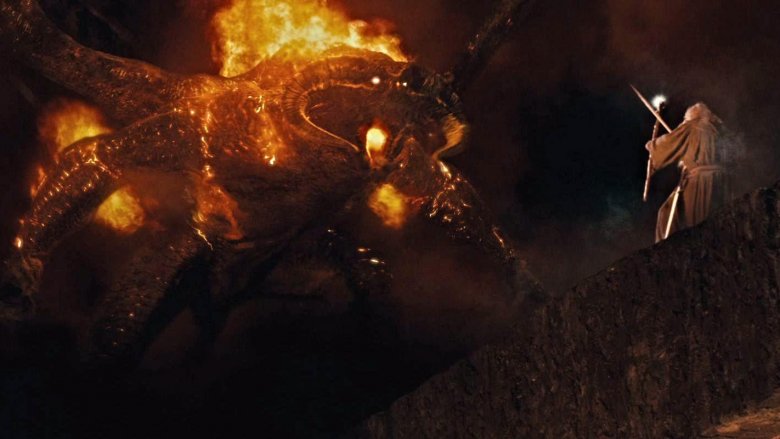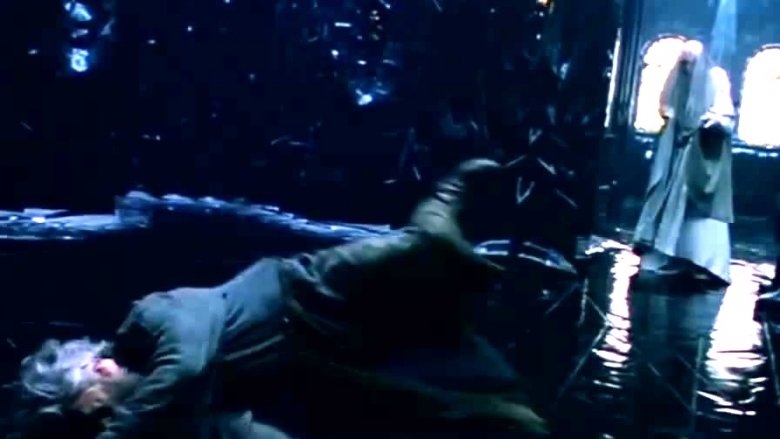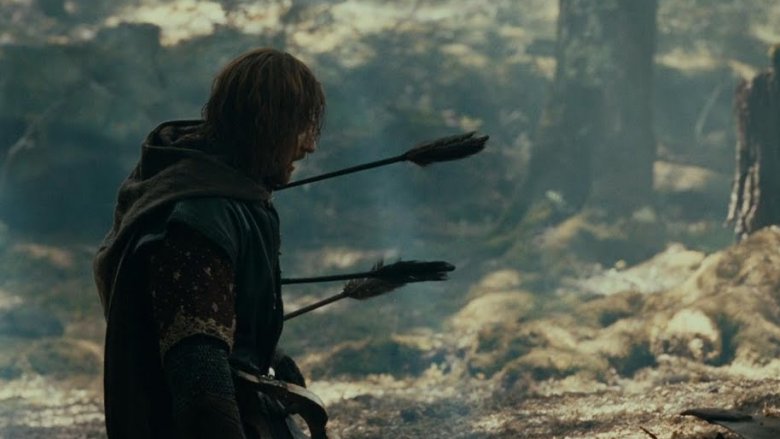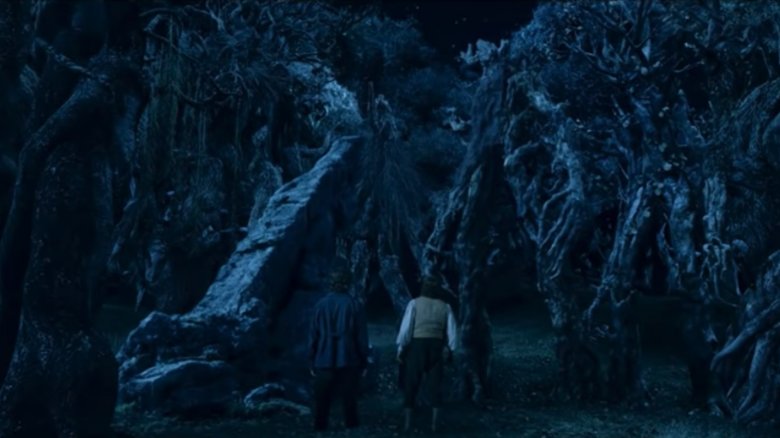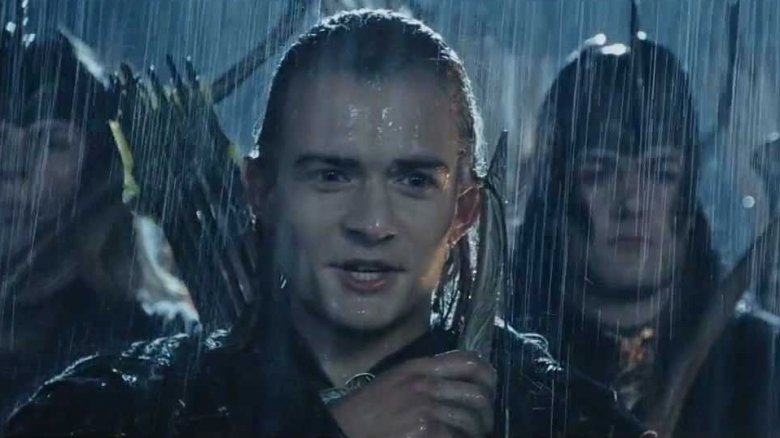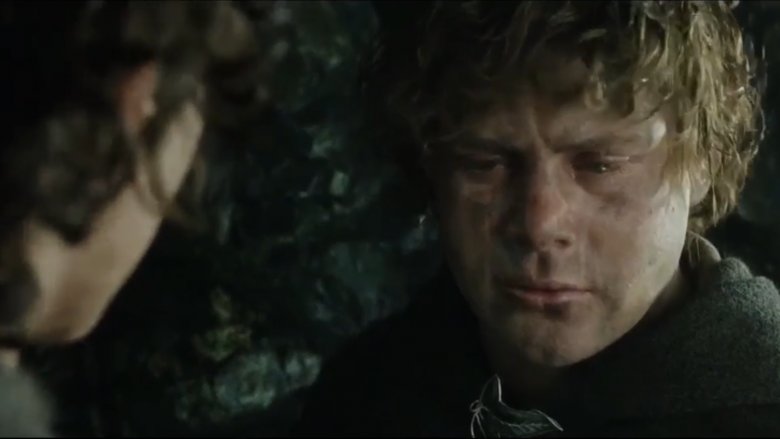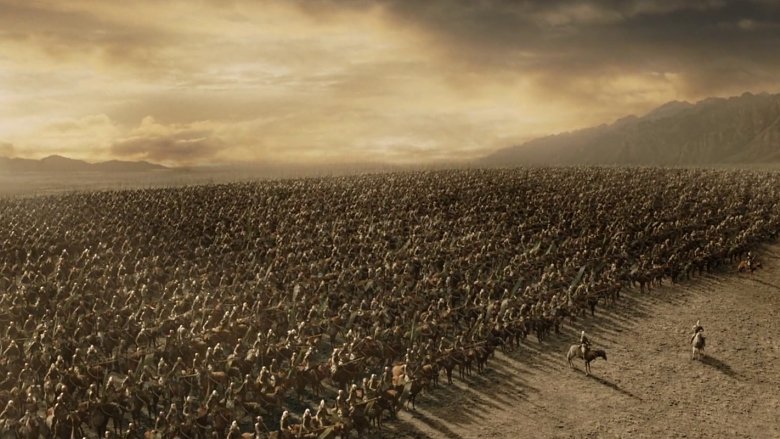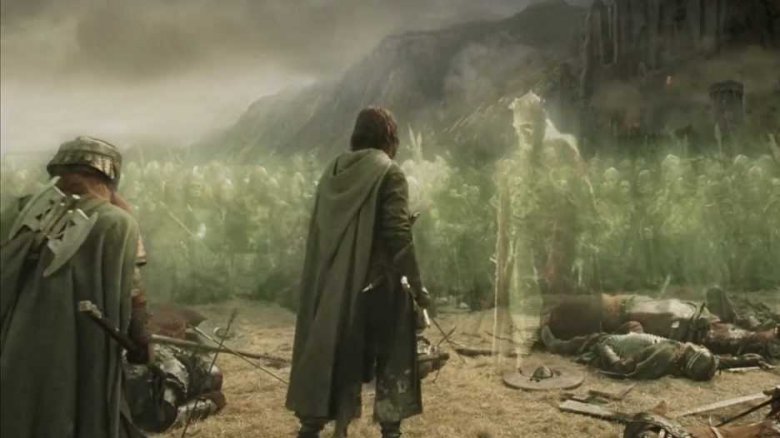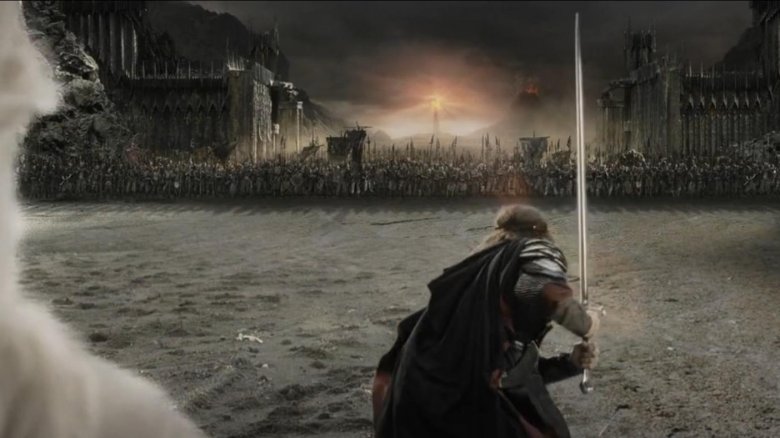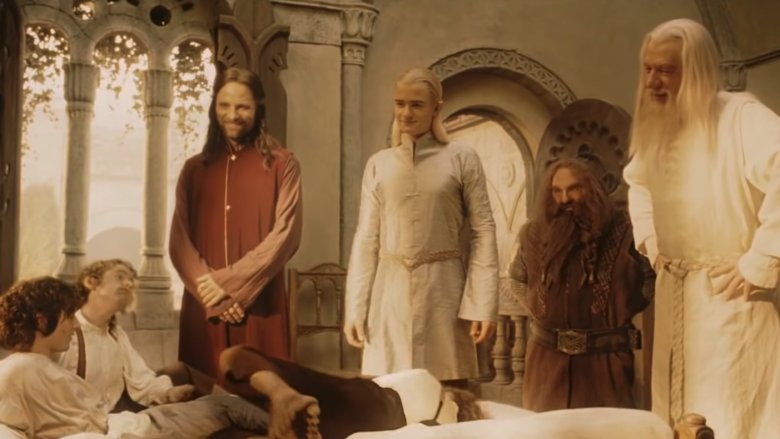5 Best And 5 Worst Scenes From The Lord Of The Rings Trilogy
Peter Jackson's film trilogy adaptation of J.R.R. Tolkien's The Lord of the Rings is one of the most critically acclaimed and financially successful franchises in recent memory. He isn't the only filmmaker to try his hand at bringing Tolkien to the screen — Amazon's production of the Oxford Don's fantasy world promises to deliver a healthy dose of quality Middle-earth as well — but it's hard to imagine anything taking the place of Jackson's beloved works.
Of course, terrific doesn't mean perfect. As with every big-budget Hollywood project, The Lord of the Rings showcased so many different story arcs, characters, and events all colliding in one set of films that it was inevitable that the trilogy would have its high points as well as some comparatively unsatisfying ones. From epic battles and witty humor to deviations from the source material and a tendency to genre-hop, let's break down five of the best and five of the worst scenes from Peter Jackson's Lord of the Rings trilogy.
Best: Gandalf takes on the Balrog in Khazad-dûm
The most memorable moment in The Fellowship of the Ring took place when Gandalf sacrificed himself to defend the slender Bridge of Khazad-dûm, all in order to buy precious time for the rest of the Fellowship to escape. The climactic scene in the book sends tingles down your spine. Converting it to the screen without dampening its grand effect was a make it or break it moment for Jackson and his crew, and they came through with flying colors.
Ian McKellen's expression is perfect as Gandalf stands there, alone in the dark, looking exhausted yet wielding a hidden power. And then there's the Balrog. In an era with characters like Thanos from the Marvel Cinematic Universe and Caesar from The Planet of the Apes franchise, it's easy to forget how cutting-edge the special effects were in these movies. The servant of Morgoth was fiercely portrayed, towering like a fiery inferno above the wizard.
The truth is, it can be extremely difficult to turn scenes like these into onscreen moments that are both believable and emotional. If it's not done right, you'll just make the audience laugh out loud. The confrontation with the Balrog in Moria showcases how much the powers that be behind the production took the task at hand seriously.
Worst: The wizard duel
Of course, while McKellen the Grey's duel with the Balrog may have been one for the ages, it doesn't mean any time Mithrandir whipped out his staff to take on an enemy mano a mano it was going to go over well. For example, the wizard duel. Anyone simply watching in the pursuit of eye-popping action sequences may have taken the bout between Gandalf and Saruman in Isengard as part and parcel of the whole Tolkien saga. But the truth is, the scene in the earlier stages of The Fellowship of the Ring feels a bit like it was taken right out of the pages of a J.K. Rowling novel. It just isn't... Tolkien.
Tolkien's wizards are wielders of deep magic, counselors, and even warriors, but one thing they don't do is go around shooting invisible shock waves out of their staffs like they're newbies at Hogwarts. Honestly, the entire scene felt a bit like a petulant standoff between a couple of kids as they threw each other across the room and flipped over onto that imposingly hard-looking glossy floor. Saruman finally ended the conflict with a quick flick of the wrist that snatched Gandalf's staff right out of his hand, but seriously, why didn't he just start with that move in the first place? The whole scene felt a bit out of place. Hardly Middle-earth material.
Best: Boromir's last stand
One of the best characters in the entire Lord of the Rings series is Boromir. The heir to the steward of Gondor provided some hearty muscle as well as a healthy dose of drama as he was slowly devoured by a consuming desire for the One Ring. His story arc peaked with his attempt to take the overpowered piece of jewelry by force from Frodo at Amon Hen, along with the subsequent events that led to his death.
While Boromir's madness quickly wore off, unfortunately, it was too late for the son of Denethor to make amends with Frodo directly. However, he found another way to redeem himself in the form of protecting Merry and Pippin, and boy did he deliver. The stressful scene as the heir to the Steward of Gondor fought off endless hordes of Uruk Hai, all the while sending distress signals on his horn, is the definition of epic. In spite of the ridiculously lopsided order of business, it ends up proving to be not one, not two, but three arrows that are required to stop the Gondorian hero in his tracks. The feathery trifecta finally brings him down just as Aragorn arrives on the scene to kill Lurtz and talk his brother in arms through his final moments. What a way to go.
Worst: The Entmoot's sheepish decisions
Another of the low points arrives when everyone's favorite resident tree herder, Treebeard, and his fellow ent counselors meet at the conclusion of the Entmoot. While the cinematic representation of the ents and their ultimate role in the sacking of Isengard is as good as gold, the path that took them there is pretty bleak, and not much like the original book. In fact, not even a little bit.
In the scene when the Entmoot finally decide whether to help in the war, Treebeard and the ents inform Merry and Pippin that they won't be participating. Merry attempts to give a rousing speech to rally them to the cause, but it falls on deaf ears... or would it be deaf bark in this case? Anyway, things are only made right when the pair of halflings trick Treebeard into "accidentally discovering" that Saruman had been devastating his forest. At that point, he calls his fellow ents and they magically appear, and ready to take on Isengard. The whole scene is laughably unrealistic — in the original tale the Entmoot decide to go to war right from the get go, attacking with a plan and purpose, which probably would have played out much more satisfyingly onscreen.
Best: Would you like me to find you a box?
One of the most endearing relationships throughout the trilogy is the friendship between Legolas and Gimli. The Prince of Mirkwood and the son of the Lonely Mountain begin with antagonism bred from a deep-seated hatred built up over the ages between elves and dwarves. However, as they travel together, the companions develop a bond so strong, it becomes a defining element of the narrative. In fact, according to Tolkien (per the Appendix of The Return of the King), it was even rumored that Gimli ultimately ended up retiring with Legolas across the seas to the Undying Lands.
While their friendship was a staple throughout the movies, one scene that stood above the rest was their warrior duel throughout the Battle of Helm's Deep. The contest ends with the son of Gloin victorious, but it starts with him clearly at a disadvantage. For one thing, when the battle begins, his Elvish competition is armed with a bow and the pair stand atop a lofty wall where the dwarf's axe wasn't very useful. Even worse, Gimli's height proved to be an issue. In one of the best one-liners of the entire anthology, Legolas looks down at his friend below the ramparts and asks him if he'd like him to find a box. Deliciously tongue in cheek, the scene brings a sense of comic relief to an otherwise grave situation.
Worst: Gollum beats Sam?
Elijah Wood did an admirable job portraying Frodo Baggins. It's a difficult role to play — much of the hero's story takes place within himself as he struggles against the lure of the Ring — so it's easy to forgive a few awkward moments from time to time. However, the writers definitely got off on an absolutely ridiculous tangent when they chose to have a subplot revolve around Frodo dismissing Sam over a handful of Lembas.
The dynamic duo is supposed to be attached at the hip from the Shire all the way through their epic trudge up the slopes of Mount Doom. By the time they reach the stairway that leads to Shelob's tunnel, the bond that carried the two hobbits across half of Middle-earth should be unbreakable. To be fair, Tolkien did originally pen a couple of scenes in which Sam fruitlessly tries to help Frodo carry the Ring, but the suggestion never comes close to causing the two to part ways. The thought that Gollum would be able to set up a scenario in which Frodo simply dismisses him — and at the encouragement of Gollum, no less — is outrageous. The two should have been together going into the Shelob sequence. Period. End of story.
Best: The arrival of the Rohirrim at the Pelennor Fields
While The Return of the King is studded from one end to the other with epic fight sequences, the best has to be the arrival and charge of the Rohirrim just in the nick of time to save Minas Tirith from complete destruction. It opens when King Theoden gives a heart-rending speech, spurring his nation to recklessly ride to ruin and the world's ending. While he may technically have been stealing a few lines from Eomer's speech in the book, the scene absolutely sends tingles down the spine, as the wave of cavalry collides with the besieging orc army.
The battle takes up a good portion of the movie and comes replete with charges, counter-charges, Oliphaunts, and even a second kill-count duel between Legolas and Gimli. But the other scene that needs to be specifically called out here is Eowyn's tête-à-tête with the Witch King. With a little timely help from Merry, the shield-maiden's "I am no man" line, followed by a last-ditch stab at the head of Sauron's most feared general, is as sweet as it gets — and a scene that bears rewatching over and over again.
Worst: Green ghosts in Gondor?
While the beginning of the Battle of the Pelennor Fields is a high point, the ending is a bit of a disappointment. To clarify, Aragorn, Legolas, and Gimli's arrival at the docks of the Harlond is definitely a climactic moment in the battle, but the enormous, floating army of translucent green warriors behind them feels out of place after all the very down-to-earth heroics beforehand.
In the original text, the army — which is decidedly not glowing green — helps get rid of the Black Fleet of Umbar, a scene which gets a nod in the extended edition of the films. After that, Aragorn releases them and sails up the river to help Minas Tirith with the living, breathing men from the surrounding coastlands. His arrival ends up tipping the scale in favor of the good guys, but it's hardly an emerald-infused ghost bonanza that overpowers everything in its way. The arrival of the army of the dead in the film screams the question "why didn't you just have this unstoppable juggernaut show up a half hour sooner?" It deflates the previous heroics a bit and feels like Jackson relapsed into some of his old school horror past. Is it fun? Sure. Is it also out of place? Absolutely.
Best: Aragorn's Black Gate speech
Toward the end of The Return of the King, the Men of the West find themselves desperately trapped in front of the Black Gate of Mordor. At this point, Aragorn fully steps into his role as the king, giving one of the best speeches in the trilogy. The spine-tingling passion behind his death-defying rallying cry is palpable as he declares that the age of men will one day come crashing down, but "it is not this day." The exhilarating speech inspires the soldiers of Gondor and Rohan to stand and fight to the death.
Aragorn's character arc throughout Jackson's trilogy is a bit erratic as he waffles between his own insecurities and the calling to be the hero he was born to be. But the Black Gate speech showcases the fact that Isildur's heir has finally, fully arrived on the scene and his evolution into a leader of men is complete. The scene is a fitting climax to his journey — and the story as a whole.
Worst: Reunion of the Fellowship
While Boromir does die in The Fellowship of the Ring, after that the remaining eight members manage to come through all the drama and action more or less intact apart from a few bumps, bruises, and a missing finger — we're looking at you, Frodo. A reunion is naturally in the cards after the Ring is destroyed, but the way Jackson goes about presenting it is a bit off, to say the least.
As Frodo wakes up after enduring the horrors of his time in Mordor and on Mount Doom, he finds himself bathed in golden light. Okay, makes sense if you're going for a bit of an ethereal feel. But from there, the scene continues to play out largely in slow motion, with tons of closeups, as everyone enters the room, jumps on the bed, stands around grinning from ear to ear and laughing... seriously, there's way too much slow-mo laughing going on. The point of the scene makes sense. After all, they survived against all odds. But seriously, watching it is just plain uncomfortable.
